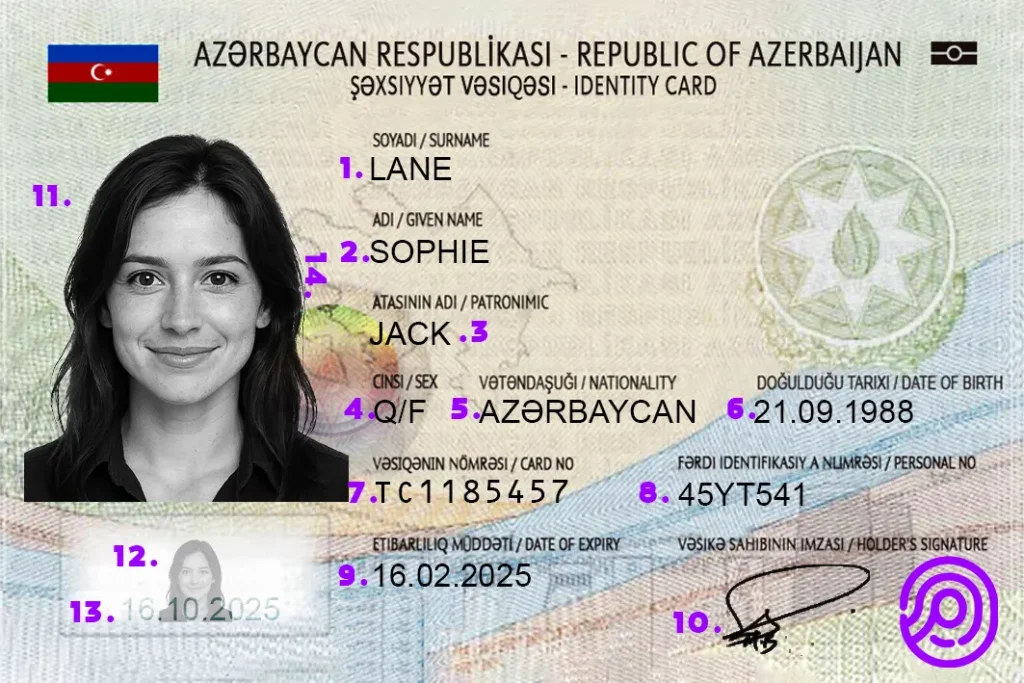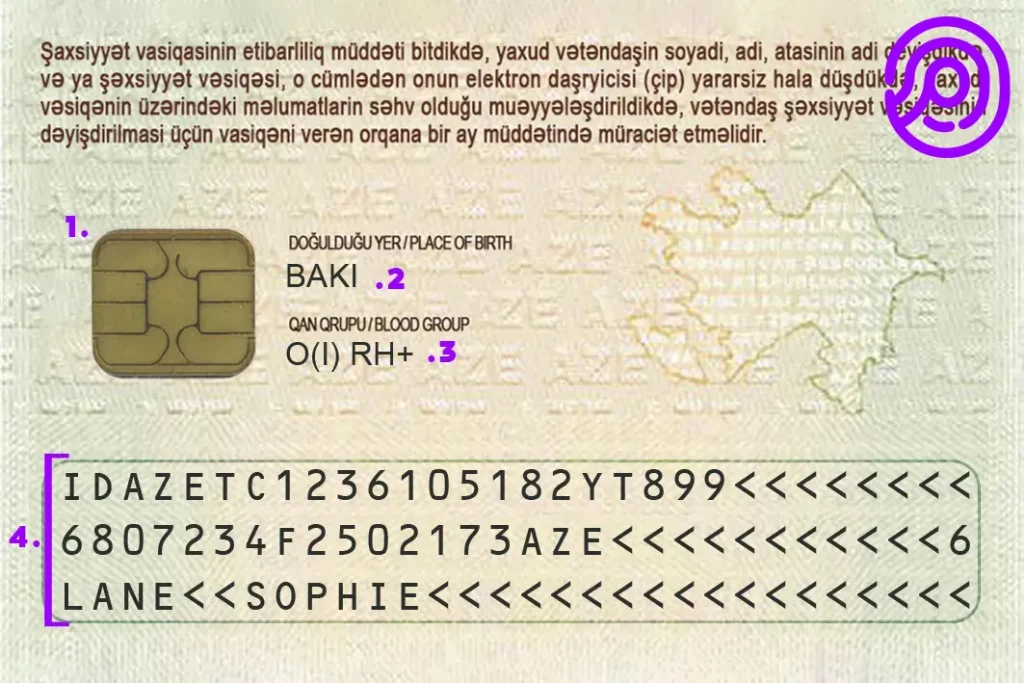Azerbaijan ID Card — Complete Overview and Element Analysis

Introduction:
The Azerbaijan ID Card is one of the most important and practical identification documents for citizens of the Republic of Azerbaijan. This card serves as an official proof of identity and is used not only for everyday purposes such as visiting governmental offices, banks, or administrative institutions, but also plays a crucial role in digital identity verification and secure access to online governmental and private systems.
In this article by Pixentry, we will carefully examine all the visual elements, components, and security details featured on the Azerbaijan ID Card to better understand the structure and design of this modern and standardized identity document.

General Specifications Azerbaijan ID Card
The current version of the Azerbaijan ID Card has been designed and produced in accordance with ICAO international standards. It is made of high-quality durable plastic, ensuring resistance against bending, humidity, and heat.
In terms of security, the card features a multi-layer reflective hologram and an NFC chip that securely stores encrypted digital information.
The card’s dimensions are 85.6 × 54 mm, identical to standard international banking or credit cards.
All inscriptions and text are printed in both Azerbaijani and English, allowing the card to be recognized and used in international contexts as well.
Overall, the Azerbaijan ID Card combines modern minimalist design, high security, and excellent readability for both physical and digital identification
Front Side Elements Azerbaijan Identification Card
As shown in the image, the front side of the Azerbaijan ID Card contains several elements, each with a specific role in confirming the holder’s identity

- Surname — The official family name of the cardholder, used in all governmental and legal records
- Given Name — The personal first name of the cardholder, which combined with the surname forms the complete identity.
- Father’s Name — A traditional and important identifier used in many Caucasus region countries for more precise individual recognition.
- Gender — Indicates the cardholder’s gender (Male / Female), usually displayed as a symbol or abbreviation.
- Nationality — Specifies the legal citizenship of the cardholder and the issuing country.
- Date of Birth — The day, month, and year of birth, essential for age verification and identity confirmation.
- Card Number — A unique number assigned exclusively to that specific card, which changes upon reissuance.
- Personal Number (PIN) — A unique personal identifier used in national and digital government systems.
- Expiry Date — Indicates the validity period of the card and when it must be renewed.
- Signature — The handwritten signature of the cardholder, used for manual verification and authentication.
- Portrait Photo (Monochrome) — The holder’s official black-and-white photograph, optimized for facial recognition in different lighting conditions.
- Ghost Image — A faint or semi-transparent duplicate of the photo, used as an anti-counterfeiting security feature.
- Transparent Expiry Date — A lightly printed version of the expiry date that enhances both design and security.
- Security Hologram — A multi-layer optical hologram that shifts color and pattern under different angles, preventing forgery or unauthorized scanning.
Back Side Elements Azerbaijan ID Card
The back side of the Azerbaijan ID Card also contains several key elements, some informational and others security-related.

- NFC Chip — An embedded electronic chip that allows secure digital data storage and contactless verification by authorized readers.
- Place of Birth — Indicates the city or region where the holder was born, a required field in Azerbaijan’s civil registry system.
- Blood Type — Basic medical information that can be useful in emergencies such as accidents or medical treatments.
- MRZ (Machine Readable Zone) — A machine-readable code printed at the bottom, containing encoded identification data that can be automatically scanned by ID readers and border systems.
Due to Azerbaijan’s security regulations and Pixentry’s internal policies, technical details about MRZ elements are not disclosed in this article.
Conclusion
In this article by Pixentry, we thoroughly analyzed all visible components and design features of the Azerbaijan ID Card.
With advanced security technologies such as multi-layer holograms, NFC chips, and ghost images, this card stands among the most modern and secure identification cards in the region. Its dual-language layout, strong structure, and elegant design make it both visually appealing and functionally reliable.
You can download the Editable PSD file of the Azerbaijan ID Card to explore its layout and structure for educational and design purposes.
Additionally, you can order a decorative or display version of this ID Card with your desired personal details directly from Pixentry. All orders are custom-designed and printed with high attention to the visual accuracy of the original card.
This article is published solely for educational and informational purposes regarding ID card design and structure.
All downloadable files and sample products provided by Pixentry are strictly intended for decorative, display, or educational use only.
Any attempt to use these cards as official identification or for unlawful purposes is strictly prohibited, and all responsibility lies with the user.
